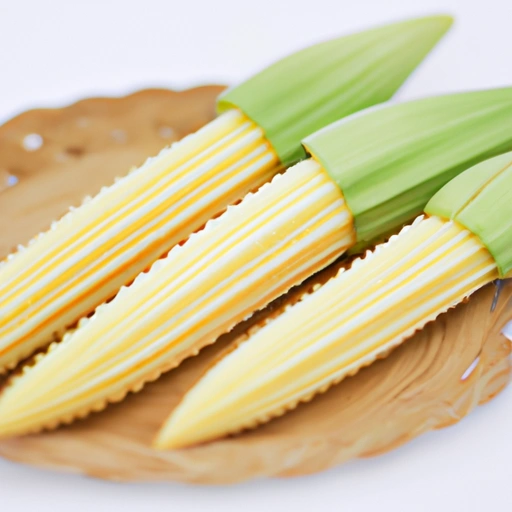Baby Corn
Description

Baby corn, also known as young corn, mini corn, or cornlettes, is a cereal grain taken from corn (maize) harvested early while the stalks are still small and immature. It typically measures about 10 cm (4 inches) in length and is often used as a vegetable in cooking rather than a grain. Known for its tender texture and subtly sweet flavor, it is a popular ingredient in various cuisines around the world and is sold both fresh and canned.
Common uses
Baby corn is commonly used in salads, stir-fries, curries, and as a garnish. Its mild taste and crunchy texture make it a delightful addition to both savory and sweet dishes. It is also popularly pickled for an added tangy flavor.
Nutritional value
Calories
Baby corn is low in calories, with about 25 to 30 calories per 100 grams (approximately 3.5 ounces).
Protein
It provides a modest amount of protein, with about 2 to 3 grams per 100 grams (3.5 ounces).
Fat
Baby corn is virtually fat-free, containing less than 1 gram of fat per 100 grams (3.5 ounces).
Carbohydrates
It contains around 5 to 10 grams of carbohydrates per 100 grams (3.5 ounces), making it a low-carb vegetable option.
Vitamins
Baby corn is a good source of some B vitamins, particularly vitamin B6, and also contains small amounts of vitamin C.
Minerals
It is rich in essential minerals like potassium, magnesium, and iron, necessary for various body functions.
Health benefits
Baby corn is high in fiber, which aids in digestion and can help maintain a healthy weight. The vitamins and minerals present in baby corn contribute to overall health, supporting immune system function and red blood cell formation.
Potential risks
As with any food, there is a risk of allergy, though this is rare with baby corn. Additionally, those who need to manage their intake of potassium or carbohydrates should consider the amounts present in baby corn.
Common recipes
Baby corn is featured in a variety of dishes, including baby corn manchurian, baby corn stir-fries, and as an ingredient in Asian noodle dishes. It is also used in Western recipes like baby corn pizza toppings, grilled baby corn, and in salads.
Cooking methods
This ingredient can be boiled, steamed, grilled, roasted, or stir-fried. It's versatile and can be cooked whole, sliced lengthwise, or chopped into smaller pieces, depending on the recipe.
Pairing with other ingredients
Baby corn pairs well with red bell peppers, onions, garlic, green beans, tomatoes, and a variety of proteins including chicken, beef, and tofu. It also complements aromatic herbs and spices such as basil, cilantro, ginger, and curry powder.
Summary
Baby corn is a versatile and nutritious ingredient that adds texture and flavor to a variety of dishes. With its origins in Asia and popularity in American and European cuisines, this ingredient has become a global favorite. Its nutritional profile makes it a healthy choice for many, while its culinary flexibility allows it to be included in numerous recipes. From stir-fries to salads, baby corn is a delightful addition to meals around the world.